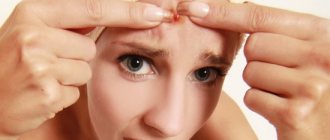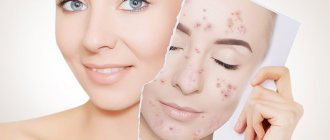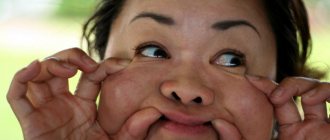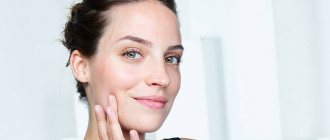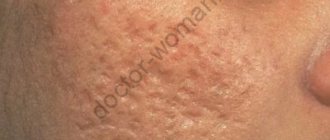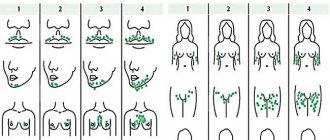Acne (acne, acne)
is a skin disease that results in disruption of the sebaceous glands.
These glands produce sebaceous secretion, which serves to moisturize the skin and protect it from environmental influences. The secretion produced by the gland enters the hair follicles. If more secretion is produced than necessary, it glues together dead skin cells, which form a plug at the mouth of the duct coming from the sebaceous gland. The hair follicle begins to bulge and rise above the skin level. Hemispherical nodules (so-called closed comedones
) appear - white acne no larger than a pinhead.
If air gets into the formation, the sebaceous plug oxidizes and turns black. This is another type of acne: blackheads or open comedones
.
The sebaceous plug is a favorable environment for the growth of bacteria, so acne becomes easily inflamed. Pimples form - red papules, cone-shaped with an abscess on the top. Inflamed acne is a cause for concern; They start touching and combing them, which is absolutely forbidden to do.
Acne and pimples can affect the skin of the face, chest and back. Acne usually occurs during puberty, but sometimes becomes chronic. Acne can occur with varying degrees of severity. In severe forms, acne is accompanied by the formation of nodules and cysts under the skin. Such formations leave behind ugly scars.
Causes of acne (acne)
Hormonal changes play a leading role in the occurrence of acne. Increased levels of the male sex hormone (androgen) stimulate the excessive productivity of the sebaceous glands. This is why acne occurs much more often in men than in women. However, during puberty, the amount of male hormones also increases in girls, so girls also face this disease. Acne worsening as menstruation approaches is also associated with hormonal changes.
At an older age, acne may indicate problems with the endocrine system. Genetic predisposition is important, since the sensitivity of the sebaceous glands to androgens and the narrowness of the sebaceous ducts can be inherited. Favorable factors for the development of acne are also:
- incorrectly selected cosmetics. Some substances used in the cosmetic industry can clog pores (they are called comedogens): lanolin, squalene, sulfur;
- hormonal drugs (oral contraceptives); some other medicines - steroids, antibiotics, antidepressants, tranquilizers, drugs containing lithium;
- stress;
- skin contamination (oil, tar, etc.);
- dry skin. Washing too often can also make the situation worse by causing the skin to become too dry;
- squeezing the skin (for example, with a telephone receiver);
- in some cases, certain foods may play the role of a provoking factor. Most often these are chocolate, carbonated drinks, nuts, coffee.
The main cause of acne
Pimples, which are also called acne or acne, are always associated with inflammatory processes that occur in the sebaceous glands. Moreover, the disease is often observed on the skin of the face and upper half of the body (chest, back), since this is where many sebaceous glands are concentrated.
Normally, they remove fat through follicles - the cellular structures from which hair grows. But often the ducts of the sebaceous glands are blocked due to the accumulation of dead skin cells, as well as the sebum itself and a mixture of other biological components. As a result, a plug is formed that interferes with the functioning of the gland.
It is because of this that inflammatory processes begin. They are accompanied by soreness, redness, suppuration and other symptoms. The main reasons for this phenomenon are changes in hormonal levels and metabolism. This is often due to age.
Prevention of acne (acne)
Since the main cause of acne is hormonal changes, there is no guaranteed way to prevent acne in a teenager. However, you can minimize the manifestations of diseases if, when the first signs of acne appear, you follow these rules:
- Do not squeeze out blackheads and pimples;
- It is recommended to wipe the affected skin areas with an alcohol solution;
- in the diet it is necessary to exclude chocolate, canned food, fatty foods;
- It is advisable to wash your face with warm water; For hygiene procedures you should use bath soap;
- Gymnastics and staying in the fresh air for at least 1-2 hours a day are useful. However, you should shower immediately after exercise, as sweat can worsen your skin condition. You should also wear as little makeup as possible if you expect to sweat;
- The impact of stress can be reduced by eating right and getting enough sleep (at least 7 hours a day).
The mechanism of acne on the face
Acne
– one of the most common dermatological diseases: according to statistics, about 80% of the world’s population experiences skin rashes. Acne most often appears against the background of hypertrophied sebum production: excess sebum clogs the pores and so-called acne appears.
Acne
- a sebaceous plug with an admixture of keratinized skin particles accumulated at the mouth of the hair follicle or the ducts of the sebaceous gland. When exposed to oxygen, sebum oxidizes and the plug acquires a characteristic dark gray color.
The sebaceous plug creates an ideal environment for the proliferation of acne bacteria (Propionibacterium acnes or Malassezia), which provoke the occurrence of inflammatory foci - acne. Such bacteria constantly live on the skin and are anaerobic, i.e. do not need oxygen to synthesize energy, so when the ducts of the sebaceous glands are clogged, an ideal airless environment is formed for their reproduction.
Acne
– an inflammatory element of the sebaceous gland, which arose against the background of blockage of its ducts by external contaminants and the proliferation of acne bacteria in them. Pimples differ from blackheads by the presence of inflammation, redness and internal purulent contents (white head).
Predominantly oily skin types are predisposed to acne. Properly selected corrective care that meets the needs of the type will help prevent the occurrence of rashes and regulate the secretion of sebum.
There are several types of rashes:
- Open comedones (blackheads) are superficial rashes that consist of compacted gray or black skin secretions (due to the oxidative reaction of the contents with oxygen).
- Closed comedones (subcutaneous acne) - the mechanism of occurrence is similar to open comedones, only the contents are located under the skin.
- Papules are small subcutaneous pimples without obvious purulent content.
- Pustules are a pimple in its standard manifestation with purulent content and a red, inflamed area.
- Nodules are hard subcutaneous nodules that protrude to the surface of the skin, often accompanied by purulent discharge.
Treatment of acne (acne)
Acne causes serious psychological discomfort. And self-treatment of acne can lead to the formation of scars and scars, especially if you try to remove acne and pimples on your own. Therefore, it is best to contact a qualified dermatocosmetologist.
Active acne treatment is aimed at solving the following problems:
- preventing the appearance of new formations (comedones);
- normalization of the amount of sebaceous gland secretion;
- destruction of existing comedones;
- suppression of bacterial growth and relief of inflammation.
Common Causes of Acne
There are several common reasons why acne occurs. Often these are internal factors, although there may also be external ones (for example, an unfavorable environment or abuse of cosmetics).
Genetic predisposition
In some cases, a predisposition to acne is inherited. If parents suffered from acne as adults, their children are more likely to suffer from acne as well. Moreover, if the pathology was observed in both parents, the child’s problem worsens.
Premenstrual acne
Steroid hormones are actively synthesized at the last stage of the menstrual cycle. Therefore, in 70% of girls, the appearance of acne is observed during the monthly cycle. They are formed in small quantities even in healthy women. Moreover, purulent pimples appear even 7-10 days after the start of menstruation. They usually protrude on the surface of the chin.
Hormonal disbalance
If acne in teenagers is a normal phenomenon, then acne after 28-30 years is definitely a violation. The most likely cause is a violation of the synthesis of sex hormones. Moreover, acne can indicate internal problems - for example, in women, the appearance of acne is often associated with polycystic ovary syndrome.
Acne also appears at different stages of pregnancy or immediately after an abortion. In this case, consultation not only with a dermatologist, but also with a gynecologist and endocrinologist is indicated. Men should also contact specialists, since self-medication may not be effective.
Hyperkeratosis
This refers to a quantitative increase in the upper layer of skin. This is due to vitamin A deficiency, high blood pressure, friction of the skin surface, and poisoning. Hyperkeratosis can also be associated with hormonal imbalance. Therefore, to clarify the cause, you will need to consult a doctor.
The influence of cosmetics
There is a connection between acne and the constant use of cosmetics (creams, powder, sunscreen and many other products). The fact is that the skin pores become clogged and sebum cannot come out, which causes inflammation and acne.
In this regard, cosmetics that include:
- squalene;
- red pigments (C and D);
- lanolin and substances based on it;
- oils (mineral, vegetable).
Climatic factor
Extended periods of heat and high humidity contribute to the formation of acne. This climate is mainly observed in the tropical and subtropical zones. Therefore, for most of Russia this factor is not relevant.
Constant contact with toxic components
Due to their professional activities, some people have to constantly come into contact with chlorine, petroleum products, tar, and lubricating oils. This has a bad effect on the skin and leads to inflammation. Also, a chemical factor can provoke the development of cancer.
Solarium
In small amounts, ultraviolet radiation destroys acne. But if you abuse the solarium, the effect will be the opposite. Therefore, such cosmetic procedures should be kept to a minimum.
Squeezing out blackheads
Squeezing can cause the acne to spread even further. This is due to the penetration of bacteria from hands and tools into the skin. In this regard, even touching your face too often carries a certain risk.
Taking hormonal medications
Acne can be a side effect of taking various hormonal medications. However, after the end of therapy, acne usually goes away on its own within a maximum of 3 months.
How to prevent acne on your face?
Proper daily care based on gentle cleansing, regular moisturizing and suppression of inflammation will help keep the situation under control.
For oily skin types, care consisting of three stages is important:
- cleansing pores of skin impurities and dead dermis,
- deep hydration and protection against dehydration,
- restoration of inflamed skin.
Choose high-quality and suitable cosmetics
Use safe cosmetics that are suitable even for sensitive skin - they do not contain potential allergens and do not cause irritation. It is best to buy such products in pharmacies - products from pharmacy brands are certified and created under the supervision of dermatologists.
The Effaclar range of care from La Roche-Posay has been tested by dermatologists, meets all the requirements of oily problem skin, and helps to effectively cope with the appearance of acne.
Comprehensive daily care will reduce inflammation and prevent the appearance of new ones.
- Provide the dermis with gentle cleansing, use gels or foams for washing that do not contain alcohol or aggressive acids. Effaclar foaming gel for oily acne-prone skin
will gently remove excess sebum and deeply cleanse pores . The gel does not dry out sensitive skin and gives it a feeling of cleanliness and freshness for a long time. - Effaclar pore tightening lotion
will help remove residual cleanser and impurities, as well as reduce pore size . The ultra-soft formula of the product gently cares for the skin, smoothing and mattifying its surface. The lotion also prepares the epidermis for the application of the cream. - The moisturizing mattifying emulsion Effaclar Mat
will provide the skin with a mattifying effect for up to 8 hours and will protect against dehydration for a long time . A product with La Roche-Posay thermal water, glycerin, zinc, perlite and the sebum-regulating component Sebulyse, mattifies the skin, eliminates excess oily shine on the face for 8 hours, tightens pores and moisturizes well. - For spot application, use corrective local product Effaclar AI
, intended for oily problem skin prone to imperfections. Keratolytic components and elements in the product suppress bacterial activity and smooth the epidermis.
EFFACLAR GEL
Cleansing gel
Cleanses skin and pores of impurities. Removes excess sebum.
951 rub. more details
EFFACLAR
Pore tightening lotion
Effectively cleanses pores. Helps reduce pore size.
RUB 1,468 more details
EFFACLAR MAT
Sebum-regulating emulsion
Eliminates oily shine. Visibly tightens pores.
RUB 1,618 more details
EFFACLAR AI
Sebum-regulating emulsion
Effectively affects imperfections. The surface of the skin is smoothed.
RUB 1,417 more details
Follow a daily skin care ritual
Stage 1: cleansing
Wash your face twice a day: morning and evening. To cleanse oily skin, choose products containing acids (salicylic or glycolic). Exfoliate your skin a couple of times a week - this will help even out the skin texture and deeply cleanse the pores.
Effaclar Micro-Exfoliating Cleansing Gel
with acids (salicylic and lipohydroxy acid) provides a micro-exfoliating effect without scrubbing particles, eliminates impurities and dead cells accumulated on the surface of the skin, preventing clogging of pores.
EFFACLAR
Cleansing gel
Reduces pronounced imperfections and post-acne. Intensively cleanses the skin.
RUB 1,218 more details
Stage 2: fight inflammation
Lotions for oily skin help to successfully combat clogged pores and inflammation. These products contain acids that dry out small pimples.
Corrective cream-gel for problem skin against imperfections and post-acne Effaclar DUO (+)
in addition to acids (salicylic and lipohydroxy acids), it contains Aqua Posae Filiformis and Mannose, known for their ability to restore the skin microbiome, which helps reduce the number of emerging inflammations, as well as procerades - to prevent stagnant spots (post-acne).
EFFACLAR DUO(+)
Corrective cream-gel
Reduces pronounced imperfections. Prevents the re-formation of imperfections.
RUB 1,187 more details
Stage 3: Hydration
With a lack of moisture, the sebaceous glands begin to work more actively, provoking the appearance of new inflammations. Remember: by moisturizing your skin, you normalize the functioning of the sebaceous glands.
Effaclar H Multi-Repairing Moisturizing Soothing Treatment
contains: ceramides that restore the stratum corneum and new generation lipids, increases the protective functions of the skin, deeply and long-term moisturizes and softens the epidermis.
EFFACLAR H
Soothing Moisturizer
Suitable for use in conjunction with drying products for problem skin.
RUB 1,458 more details
Acne skin care
In addition to a visit to a gynecologist-endocrinologist who will prescribe appropriate hormonal treatment, proper daily skin care for acne is very important:
- Choose a good acne treatment cream
. Preparations containing salicylic acid, alpha hydroxy acids, lactic, glycolic or azelaic acid have antimicrobial, anti-inflammatory, exfoliating and healing properties. - Thorough facial cleansing is necessary
. Using makeup removers alone is not enough; you also need to wash your face with plain water, toner or micellar liquid. After properly cleaning the skin, the cotton swab should be completely clean. - Use exfoliating products.
Peels are the most recommended. As a rule, one procedure per week is sufficient. However, peeling should not be used by people with delicate, sensitive skin as it may cause irritation. - Limit decorative makeup.
It is not recommended to use a thick layer of foundation and powder, which additionally blocks the openings of the sebaceous glands and increases inflammatory changes in the skin.
It is important to remember that treating acne in adults is a long and difficult journey, so you should be patient and work on leading a healthy lifestyle. The condition of the whole organism depends on how we live. Regular exercise, quitting smoking, and a well-balanced diet provide invaluable assistance in the process of acne therapy.
Proper nutrition
What to do if acne on the face does not go away: treatment methods
If you are unable to cope with acne exacerbation on your own at home, make an appointment with a dermatologist. The specialist will prescribe additional tests if necessary and prescribe appropriate medication. To get rid of acne, the beauty salon offers several types of cleansing, as well as mesotherapy. It is important to remember that during the period of relapse of rashes, you should refrain from any cosmetic manipulations.
Regular corrective care and compliance with all the preventive measures described above will help maintain the normal condition of oily skin and minimize the risk of new acne on the forehead and cheeks.
